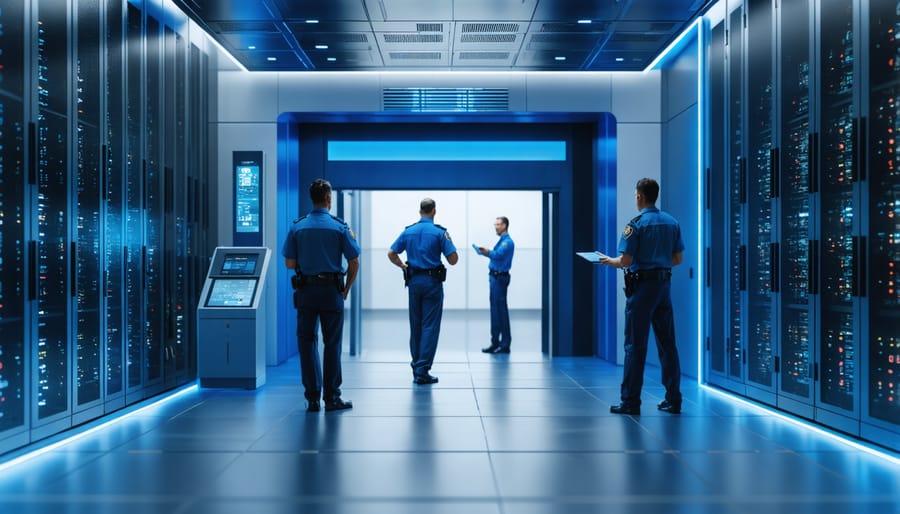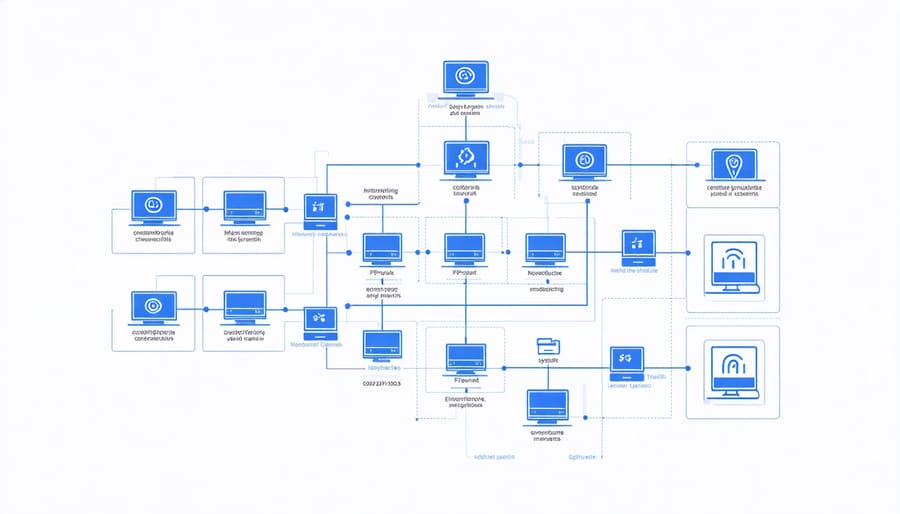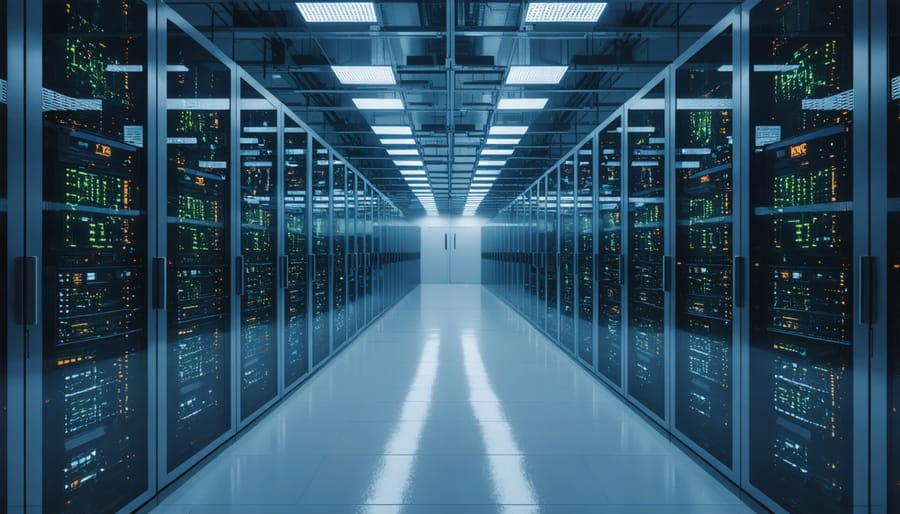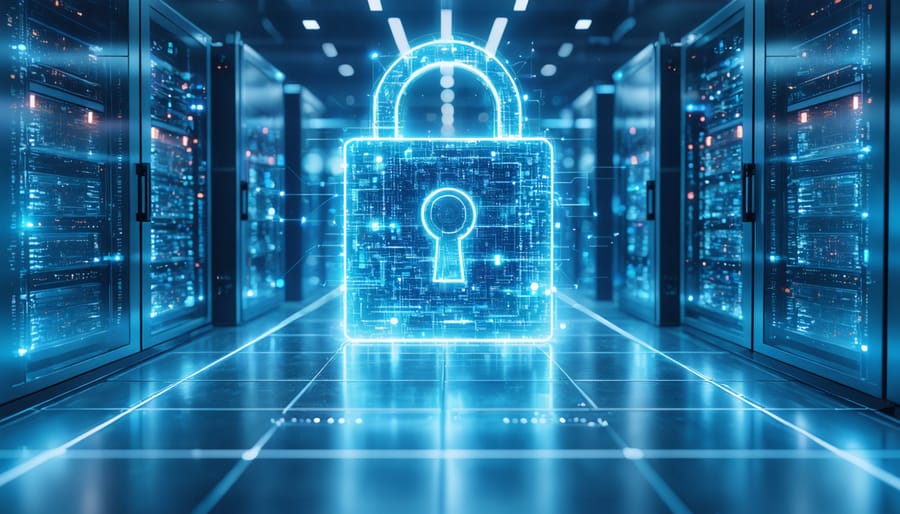Fortify your data center’s defense infrastructure against increasing security threats through a multi-layered security framework that protects both physical assets and digital information. Modern construction projects generate massive amounts of sensitive data—from proprietary designs to client financial information—requiring robust security controls that meet ISO 27001 and NIST standards. Leading construction firms implement advanced biometric access systems, AI-powered surveillance networks, and zero-trust architecture to safeguard their mission-critical infrastructure. The convergence of operational technology (OT) and information technology (IT) in construction data centers demands a comprehensive security approach that addresses both cyber and physical vulnerabilities while ensuring seamless project delivery and regulatory compliance. This integrated security strategy has become non-negotiable as construction companies increasingly rely on cloud services, Building Information Modeling (BIM), and Internet of Things (IoT) devices to manage complex projects and sensitive client data.
Physical Security Architecture
Perimeter Defense Systems
Modern data center perimeter defense employs a sophisticated multi-layered approach that begins well before reaching the facility’s walls. The outermost layer typically features reinforced security fencing with anti-climb and anti-cut properties, often incorporating fiber optic intrusion detection systems that instantly alert security personnel to potential breaches.
Vehicle access points are secured through a combination of hydraulic bollards, wedge barriers, and crash-rated gates designed to prevent forceful entry attempts. Security checkpoints utilize advanced biometric authentication systems, including facial recognition and fingerprint scanning, working in conjunction with traditional access card systems.
Surveillance coverage includes overlapping zones of high-resolution cameras with infrared and thermal imaging capabilities, eliminating blind spots and ensuring 24/7 monitoring regardless of lighting conditions. These systems are augmented by motion sensors, laser tripwires, and pressure-sensitive flooring in critical areas.
Building exteriors incorporate bullet-resistant glass, reinforced walls, and specialized RF-shielding materials to prevent electromagnetic surveillance. Mantrap entries create secure zones where visitors undergo thorough screening before gaining access to internal areas. Security personnel monitor these systems from hardened control rooms equipped with redundant power supplies and communication systems.
Regular security audits and penetration testing ensure these defenses remain effective against evolving threats, while integrated alarm systems provide immediate response capabilities through direct links to local law enforcement.

Access Control Implementation
Modern data centers employ multi-layered access control systems that combine biometric authentication, smart card technology, and stringent personnel verification protocols. Biometric systems typically include fingerprint scanners, retinal scanners, and facial recognition technology, ensuring that only authorized personnel can enter sensitive areas. These systems provide non-transferable, unique identification methods that are virtually impossible to duplicate.
Smart card systems complement biometric authentication by requiring personnel to present encoded identification cards with embedded security chips. These cards often incorporate RFID technology, enabling contactless access while maintaining detailed access logs. The combination of “something you have” (smart card) and “something you are” (biometrics) creates a robust two-factor authentication system.
Personnel authentication protocols establish clear procedures for visitor management, contractor access, and employee verification. These protocols typically include:
– Pre-approval processes for all visitors
– Temporary access card issuance with limited privileges
– Mandatory escort policies for non-cleared personnel
– Regular audit trails of access attempts and movements
– Real-time monitoring of access points
Modern systems also integrate with building management systems to create zone-based access levels, allowing organizations to restrict access to specific areas based on job roles and security clearance levels. This granular control ensures that personnel can only access areas essential to their work functions, minimizing potential security risks while maintaining operational efficiency.
Cybersecurity Infrastructure

Network Security Protocols
Network security protocols form the backbone of modern data center protection, implementing multiple layers of defense against cyber threats while ensuring seamless operations. Robust firewall systems serve as the first line of defense, filtering incoming and outgoing traffic based on predetermined security rules tailored to construction industry requirements. These next-generation firewalls can identify and block suspicious patterns while maintaining essential communications for project management and collaboration tools.
Encryption plays a crucial role in digital asset protection, particularly for sensitive project data, financial information, and intellectual property. Industry-standard protocols such as TLS 1.3 and AES-256 encryption ensure that data remains secure both in transit and at rest, while VPN technologies enable secure remote access for distributed project teams.
Advanced network monitoring systems provide real-time visibility into data center operations, utilizing AI-powered analytics to detect anomalies and potential security breaches. These systems can identify unauthorized access attempts, malware signatures, and unusual data transfer patterns specific to construction operations. Intrusion Detection and Prevention Systems (IDS/IPS) work alongside Security Information and Event Management (SIEM) solutions to provide comprehensive threat detection and response capabilities.
Regular security audits and penetration testing help validate the effectiveness of these protocols, ensuring compliance with industry standards such as ISO 27001 and NIST frameworks. This systematic approach to network security helps construction organizations maintain operational continuity while protecting valuable digital assets from increasingly sophisticated cyber threats.
Threat Detection Systems
Modern data centers require sophisticated threat detection systems to maintain the highest level of security for protecting sensitive construction data and critical infrastructure. These systems combine multiple layers of monitoring technologies and response protocols to identify and mitigate potential security breaches in real-time.
Advanced intrusion detection systems (IDS) and intrusion prevention systems (IPS) continuously monitor network traffic for suspicious activities. These systems utilize machine learning algorithms to establish baseline behavior patterns and flag anomalies that could indicate security threats. Environmental monitoring systems track temperature, humidity, and power conditions, alerting facility managers to potential infrastructure risks before they impact operations.
Video analytics platforms enhance traditional surveillance by automatically detecting unauthorized access attempts, tailgating incidents, and suspicious behavior patterns. These systems can integrate with access control databases to verify personnel credentials and movement patterns throughout the facility. Motion sensors, coupled with intelligent lighting systems, provide additional layers of security during off-hours.
Security Information and Event Management (SIEM) systems consolidate data from multiple security controls, providing a comprehensive overview of the facility’s security status. This integration enables rapid incident response and helps security teams identify patterns that might indicate coordinated attacks or systematic vulnerabilities.
Regular penetration testing and vulnerability assessments ensure these systems remain effective against evolving threats. Security teams conduct periodic drills to validate response protocols and maintain operational readiness. This proactive approach to threat detection helps maintain compliance with industry standards while ensuring maximum protection for critical construction data and infrastructure assets.
Environmental Controls
Climate Management Systems
Climate management systems play a critical role in maintaining optimal conditions for data center operations and protecting sensitive equipment. These systems employ sophisticated temperature control mechanisms to maintain the ideal operating temperature range of 18-27°C (64-81°F), ensuring maximum efficiency and equipment longevity.
Modern data centers utilize precision cooling systems with redundant CRAC (Computer Room Air Conditioning) units strategically positioned to create uniform airflow patterns. Hot and cold aisle containment strategies optimize cooling efficiency by preventing the mixing of hot and cold air streams, resulting in significant energy savings and improved equipment performance.
Humidity control is equally crucial, with recommended relative humidity levels maintained between 40-60%. Advanced humidity sensors and control systems work in concert to prevent both excessive moisture, which can lead to condensation and equipment corrosion, and overly dry conditions that may cause static electricity buildup.
Environmental monitoring systems provide real-time data through an integrated network of sensors, enabling facility managers to track temperature and humidity variations across different zones. These systems feature automated alerts and emergency responses to address any deviations from prescribed parameters.
Regular maintenance and calibration of climate management components ensure consistent performance and early detection of potential issues. Many facilities implement N+1 redundancy in their cooling infrastructure to maintain continuous operation even during system maintenance or unexpected failures.

Disaster Prevention
Data center disaster prevention systems are critical components that protect valuable IT infrastructure and sensitive data from catastrophic events. Modern facilities employ sophisticated fire suppression systems, typically utilizing clean agent suppressants like FM-200 or NOVEC 1230, which effectively extinguish fires without damaging electronic equipment. These systems are coupled with early warning detection mechanisms, including VESDA (Very Early Smoke Detection Apparatus) technology, which can identify potential fire threats before they escalate.
Flood protection measures incorporate multiple defense layers, starting with strategic site selection above flood plains and proper building envelope design. Critical infrastructure is typically elevated on raised floors, with comprehensive drainage systems and moisture detection sensors installed throughout the facility. Waterproof barriers and sealed cable penetrations prevent water ingress, while redundant sump pumps ensure rapid water removal if breaches occur.
Environmental monitoring systems continuously track temperature, humidity, and air quality, triggering automated responses to maintain optimal conditions. Structural reinforcement against seismic activity is implemented in accordance with local building codes, with equipment properly secured and braced. Regular disaster simulation drills and updated emergency response protocols ensure staff readiness for various scenarios.
These preventive measures are integrated into the facility’s building management system (BMS), providing real-time monitoring and automated responses to potential threats, while maintaining detailed logs for compliance and insurance requirements.
Compliance and Certification
Data center security controls must comply with numerous industry standards and regulatory requirements to ensure the protection of sensitive construction data and infrastructure. Key certifications include ISO 27001 for information security management systems, which provides a framework for implementing and maintaining comprehensive security controls. The Uptime Institute’s Tier Classification System, ranging from Tier I to Tier IV, sets stringent requirements for data center infrastructure reliability and security.
Construction organizations must also adhere to regional compliance standards such as GDPR in Europe, HIPAA for healthcare-related data, and PCI DSS for payment information security. These regulations influence modern security requirements and shape the implementation of physical and digital security measures.
The SSAE 18 SOC 2 certification has become increasingly important, focusing on five trust principles: security, availability, processing integrity, confidentiality, and privacy. For construction data centers, achieving SOC 2 compliance demonstrates commitment to protecting sensitive project information and intellectual property.
NIST Special Publication 800-53 provides a comprehensive framework for security controls, while the TIA-942 standard specifically addresses telecommunications infrastructure and architectural requirements for data centers. These standards ensure proper implementation of access control systems, surveillance equipment, and environmental monitoring.
Regular compliance audits and certifications renewal processes are essential to maintain security standards. Organizations should establish a dedicated compliance team responsible for monitoring regulatory changes, implementing updates, and ensuring continuous adherence to industry requirements. Documentation of security protocols, incident response procedures, and employee training programs must be maintained to demonstrate compliance during audits.
The certification process typically involves independent third-party assessments, penetration testing, and detailed documentation review. Construction organizations should prioritize obtaining and maintaining relevant certifications to ensure trust, demonstrate security commitment, and meet client requirements for data protection.
The implementation of robust data center security controls remains paramount in today’s construction industry, where digital assets and sensitive project information require unprecedented levels of protection. As we’ve explored throughout this article, a multi-layered approach combining physical security measures, cybersecurity protocols, and operational procedures provides the most effective defense against evolving threats.
Looking ahead, construction companies must prepare for emerging challenges in data center security. The integration of IoT devices, increased adoption of cloud services, and the growing sophistication of cyber threats will require continuous adaptation of security strategies. Smart building technologies and automated systems will demand more sophisticated security protocols, while compliance requirements will likely become more stringent.
Key considerations for future-proofing data center security include implementing AI-powered surveillance systems, adopting zero-trust architectures, and establishing comprehensive disaster recovery plans. Construction firms should also focus on regular security audits, employee training programs, and maintaining up-to-date documentation of security protocols.
Success in data center security requires ongoing collaboration between IT professionals, facility managers, and construction teams. By maintaining vigilance, embracing technological advancements, and fostering a security-first culture, construction companies can protect their valuable data assets while supporting innovation and growth in the industry.
As the construction sector continues to digitalize, investing in robust data center security controls isn’t just a regulatory requirement—it’s a strategic imperative for long-term success and sustainability.

